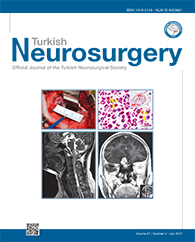2Xingtai People?s Hospital, Department of Neurosurgery, Hebei Province, China DOI : 10.5137/1019-5149.JTN.17104-16.2 AIM: To evaluate the surgical strategies and functional outcomes of intramedullary cervicomedullary ependymoma (ICE).
MATERIAL and METHODS: The authors retrospectively reviewed the clinical and imaging data of 28 ICE patients who underwent surgical resection, including 11 males and 17 females and the average age was 37.9 years (range:11-69 years). The modified McCormick grading system (mMG) was used to evaluate the neurological functions before surgery, at discharge and at long-term follow-up.
RESULTS: Gross total resections (GTRs) were performed in 21 patients (75.0%), and subtotal resections (STRs) were achieved in the other 7 patients (25.0%). An ill-defined tumor border was a significant factor leading to STR (p=0.026). At discharge, the mMG improved in 11 patients (39.3%), stabilized in 14 (50.0%), and worsened in 3 (10.7%). The 3 patients with deterioration were all in the STR Group and the neurological deterioration rate was significantly higher in the STR Group than that in the GTR Group (p=0.011). The follow-up period ranged from 9 to 77 months (mean 49.6±26.9 months). Two patients (7.1%) had tumor recurrence during this period. The long-term follow-up mMG was improved in 25 patients (89.3%), stabilized in 3 (10.7%), and no one worsened, compared with preoperative mMG.
CONCLUSION: GTR of ICE could be achieved in majority of patients, especially for those with well-defined tumor boundaries. GTR lead to a better outcome in the short term after surgery. A favorable functional outcome could be achieved for most ICE patients in the long term.
Keywords : Ependymoma, Cervical spinal cord, Medulla oblongata, Intramedullary, Prognosis




